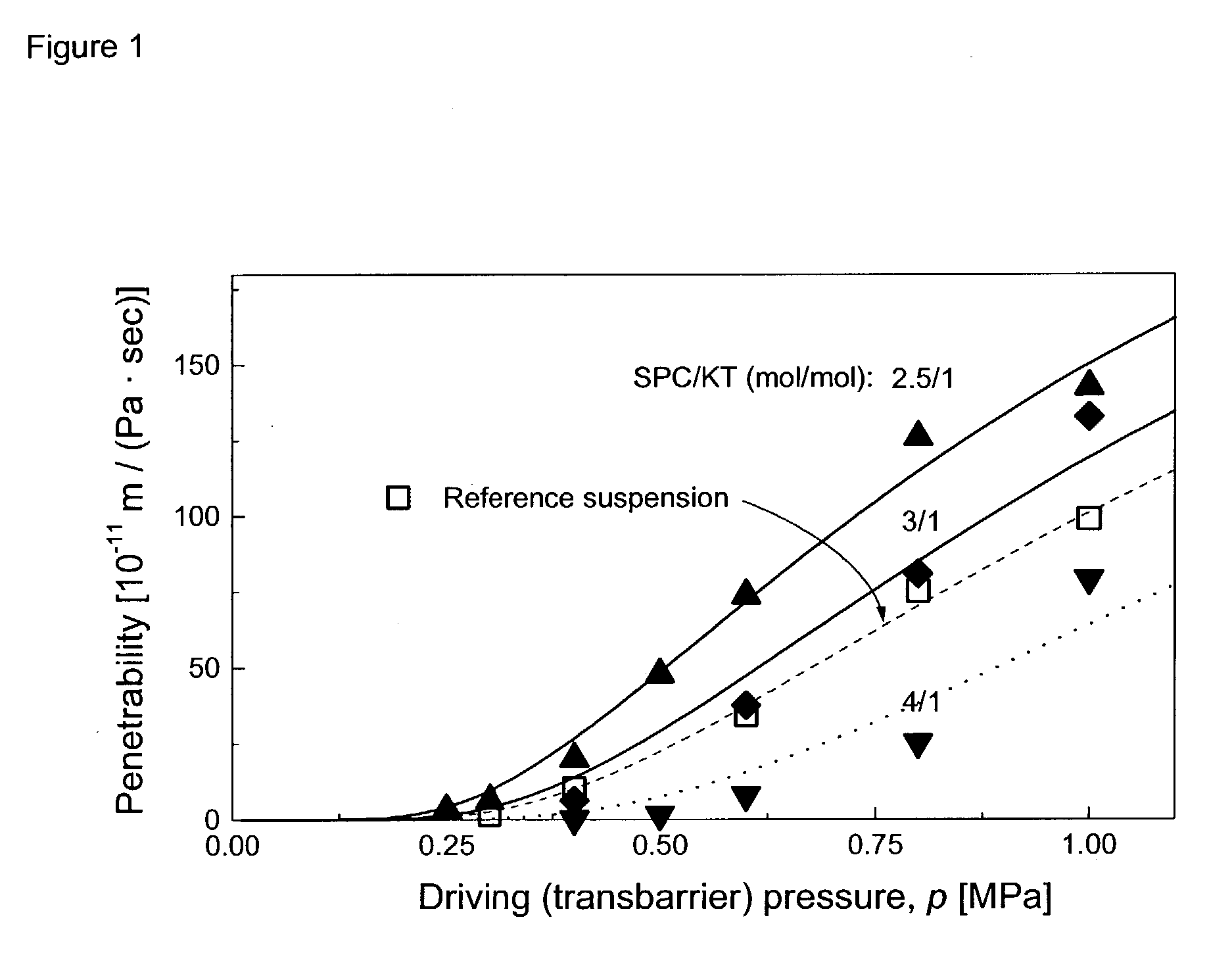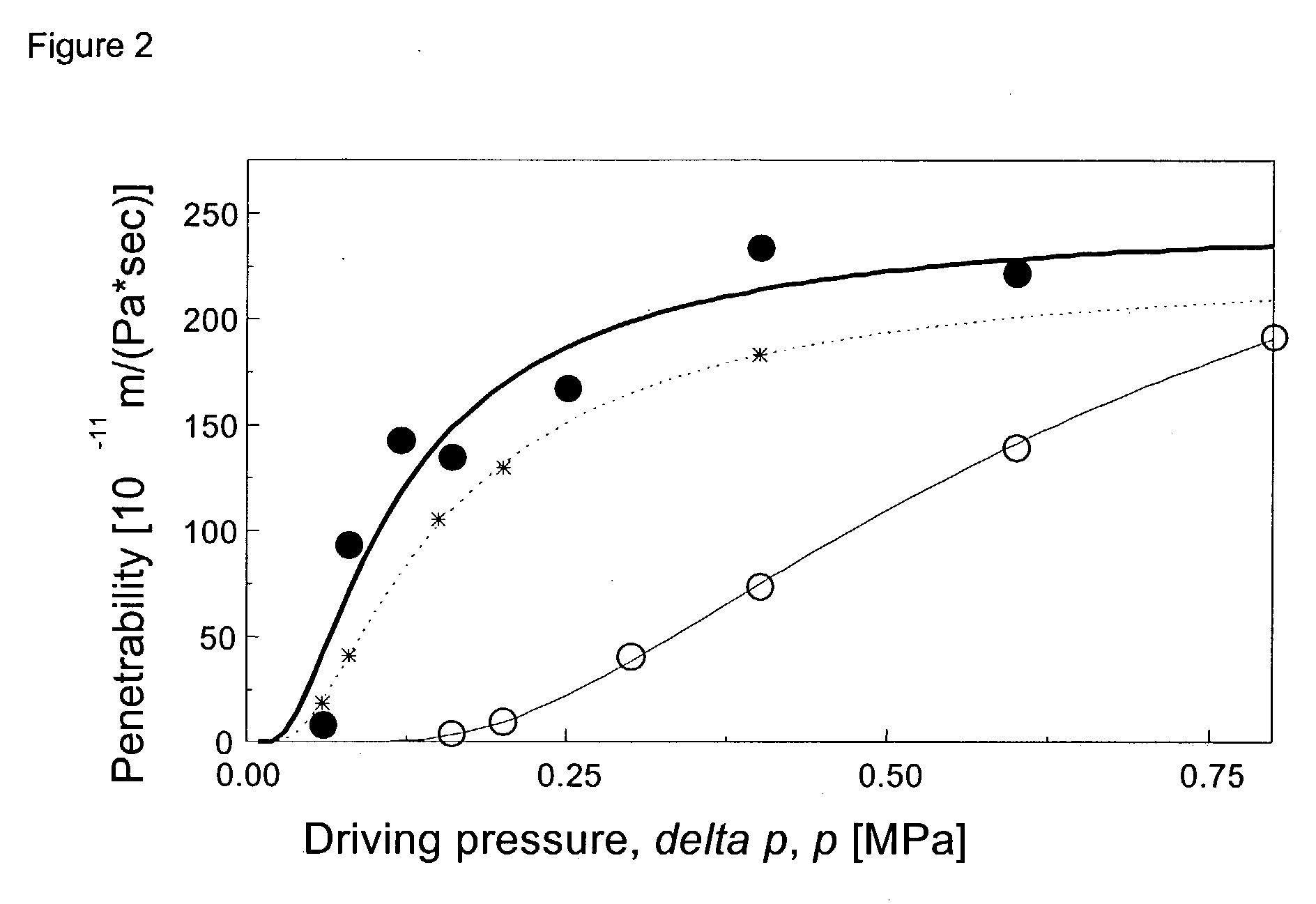NSAID formulations, based on highly adaptable aggregates, for improved transport through barriers and topical drug delivery
a technology of adaptable aggregates and formulations, applied in the direction of pharmaceutical delivery mechanisms, drug compositions, organic active ingredients, etc., can solve the problems of reducing the adapt occlude the skin, and the inability to use lipid vesicles. beneficial, and the deformability of lipid aggregates is reduced
- Summary
- Abstract
- Description
- Claims
- Application Information
AI Technical Summary
Problems solved by technology
Method used
Image
Examples
examples 1-4
[0104]
2 Composition: 80.0-71.4 mg Phosphatidylcholine from soy-bean (SPC) 20-28.6 mg Ketoprofen, sodium (KT), replacing SPC in the suspension to achieve constant amphipat amount add 1 ml Phosphate buffer, pH = 7.2, if necessary readjusted with NaOH
[0105] Objective: to demonstrate that ketoprofen, an NSAID, acts as membrane destabilising component and can render mixed amphipat aggregates with extended surface adaptable enough to penetrate narrow pores.
[0106] Test suspension preparation. The stated phospholipid and drug amounts were brought into suspension using mechanical homogenisation. That resulting average aggregate diameter was around 100 nm. For reference, a comparable suspension containing SPC and sodium cholate in 3.75 / 1 mol / mol ratio was used.
[0107] Vesicle transport ability (pore penetration capability / adaptability-). The efflux of the test suspension from a vessel pressurised with nitrogen gas was measured as a function of the time to determine the pressure dependency of m...
examples 5-7
[0110]
4 Composition: 75.0, 75.0, 37.7 mg Phosphatidylcholine from soy-bean (SPC) 25.0, 25.0, 0.0 mg Ketoprofen, sodium (KT) 0.0, 25.4, 62.3 mg Tween 80 0.0, 0.0, 37.7 mg Ethanol add 1 ml Phosphate buffer (pH = 7.2)
[0111] Objective: to test the synergistic effect of the second and first membrane destabilising amphipat (Tween 80, ketoprofen, respectively) in terms of an extended surface aggregate adaptability.
[0112] Suspension preparation was essentially the same as with examples 1-4.
[0113] Vesicle transport ability (pore penetration capability / adaptability-). Transbarrier flux of the test suspension containing 5 mol-% Tween is much higher than for the formulation that contains merely phospholipid (as the basic amphipat) and ketoprofen (as the surface active, membrane destabilising, surfactant-like amphipat) components. This is clearly seen from FIG. 2, which illustrates pressure dependence of said suspension flux divided by driving pressure.
examples 8-12
[0114]
5 Composition of aggregates: 75.0 mg Phosphatidylcholine from soy-bean (SPC), the actual value is: 75 mg - Tween 80 amount in mg 25.0 mg Ketoprofen, sodium (KT) see the following Tween 80 table add 1 ml Phosphate buffer (pH = 7.2)
[0115] Reference buffer: Phosphate buffer (pH=7.2)
[0116] Objective: to study the effect of relative concentration of a surfactant, as the second membrane destabilising amphipat, on adaptability of extended surface mixed amphipat aggregates.
[0117] Suspension preparation: as with examples 1-4.
[0118] Vesicle transport ability (pore penetration capability / adaptability-) data, as measured in this test series, confirm and expand the findings obtained with examples 1-4. Tween acting as the second membrane destabilising component improves the ability of test suspension to penetrate barriers even when this surfactant is present in the quaternary mixture merely in small amount, as long as relative concentration of Tween is at least approximately 2.5 mol-%, and ...
PUM
| Property | Measurement | Unit |
|---|---|---|
| Fraction | aaaaa | aaaaa |
| Fraction | aaaaa | aaaaa |
| Time | aaaaa | aaaaa |
Abstract
Description
Claims
Application Information
 Login to View More
Login to View More - R&D
- Intellectual Property
- Life Sciences
- Materials
- Tech Scout
- Unparalleled Data Quality
- Higher Quality Content
- 60% Fewer Hallucinations
Browse by: Latest US Patents, China's latest patents, Technical Efficacy Thesaurus, Application Domain, Technology Topic, Popular Technical Reports.
© 2025 PatSnap. All rights reserved.Legal|Privacy policy|Modern Slavery Act Transparency Statement|Sitemap|About US| Contact US: help@patsnap.com



